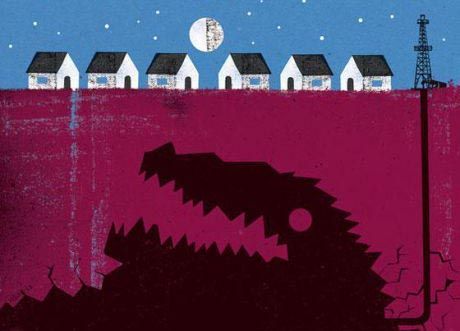Features
You are here
BC Liberals' clean LNG dreams are really a dirty nightmare

February 3, 2014
The climate footprint of Alberta’s tar sands is one of the worst of many environmental atrocities committed by Canada’s government and corporations. If the Liberal Government of British Columbia gets their way, they will create a Liquefied Natural Gas (LNG) industry with an even larger carbon footprint than even the tar sands.
In public light and media affairs the BC Liberals have always attempted to hold on to the security of the “green” image tightly. However, this sharply contrasts the Liberals actions on LNG production: proposing to build more than half a dozen plants be built along the coast. The Pembina Institute has estimated that if five of the proposed plants go into production and operate at full capacity, they would produce almost 63 million tons of carbon emissions. To put this number into perspective, Environment Canada has estimated that in 2010 Alberta’s tar sands produced 48 million tons of carbon emissions. Not only would this release more carbon emissions than the tar sands, but as a detrimental collective effort the two provinces would be contributing to even greater irreversible climate devastation. Like the tar sands and its pipelines, fracking and LNG pipelines devastate indigenous land and violate indigenous sovereignty.
The myth of “clean” LNG
Promoting the Liberals clean energy fallacy, Premier Christy Clark has repeated stated, “We have set a goal to have the cleanest LNG in the world.” Currently the “cleanest” LNG plants are Norway’s Statoil's Snohvit facilities and Australia’s Gorgon plant. Although these facilities are relatively cleaner than most LNG operations, for each ton of LNG they produce, roughly one-third of a ton of carbon is also released into the atmosphere. But if the BC plants burn their own gas for power, rather than using hydro-electricity, “LNG produced in British Columbia would emit more than three times the carbon pollution of that produced in current world-leading operations,” according to a study by Clean Energy Canada.
But even if it is powered by hydro-electricity, “clean” LNG is impossible. According to analysis by the Post Carbon Institute that takes into account the carbon costs associated with fracking to get the gas in the first place, “Shale gas full cycle greenhouse gas emissions are higher than coal when comparing both the existing electricity generating fleets and best-in-class electricity generation technologies for both fuels over a 20-year timeframe basis, and lower than coal on a 100-year timeframe basis.”
The International Energy Agency has determined that if climate destruction is to be avoided, two-thirds of the world’s remaining fossil fuels must be not be extracted. Furthermore BC's own Greenhouse Gas Reduction Targets Act sets our target carbon pollutants in the year of 2020 to a level of 33 per cent less than those of 2007. Clearly, the Liberal government’s priorities are with the gamble of short term LNG profits rather than the sustainability and long term quality of life.
The fracking well and LNG pipelines cross unceded indigenous land, and last year, the five Wet'suwet'en clans banned all pipelines on their territories. As Hereditary Chief Na'moks of the Wet'suwet'en First Nation's Tsayu Clan explained, "you have to actually look back to the very beginning of where do they get these here gases from. When you're talking about fracking and the dangers that come with it--the waste of water, the poisoning of water, the waste of land, the poisoning of that land. When we allow pipelines we have to take responsibility, we're supporting that industry to continue that. As Wet'suwet'en we can't do that."
Section:










